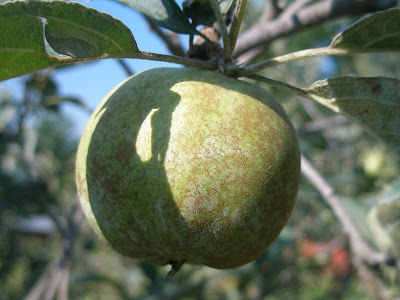The second variety to come ripe in the orchard, this early season apple took me by surprise. Unlike many early varieties, I actually enjoyed eating this one. It has amazing texture for an apple that is ripe in August and the flavor is still very acidic, but also sweet. If it weren't still in the 80's I could almost be convinced I was eating a Goldrush.
Like its end-of-the-season counterpart, Pristine is also a product of the Purdue-Rutgers-Illinois (PRI) cooperative apple breeding program. It was released for commercial planting in the mid '90s and luckily for me has shown resistance or immunity to Apple Scab, Fireblight, Powdery Mildew and Cedar Apple Rust.
The other added benefit of this variety is that it has amazing storage properties for an early apple. Even after days without refrigeration the apples still retained a great texture that varied only slightly from the first one I bit into straight off the tree.
A LIFE OF APPLES
Monday, August 15
Monday, August 8
Early Harvest
Wednesday, August 3
Catching Up
The summer has flown by and although this blog has been idle since bloom, the orchard has been a bustling place. Spraying, mowing, thinning and summer pruning have taken up much of my time, while the apples have grown and the plums have ripened. Rather than spending what feels like precious minutes or hours this time of year, writing about the past several months in the orchard I have put together a photo journal of sorts. As they say, a picture speaks a thousand words, so this will by far me my longest post yet!
 |
| Fruit set, the miracle of pollination |
 |
| Baby Pears |
 |
| A freshly mowed orchard |
 |
| "Silver Tree" Good coverage of Kaolin Clay |
 |
| Almost time to thin |
 | |
| Adolescent Pear. "They just grow up so fast" |
 |
| Thinning Time |
 |
| Infested apples are thinned and removed from the orchard |
 |
| Sometimes you just can't pick one |
 |
| Prune plums |
 |
| The first plums |
 |
| So many plums |
 |
| Summer Bounty |
 |
| Apples are getting big! |
 |
| Freedom. A very prolific variety with beautiful fruit |
 |
| Showing some blush |
 | |
| Paula Reds. These will come off the tree within the month |
 |
| Clapp Pears. Starting to color up, but they still need a few more months. |
Wednesday, May 18
Bloom
Although the rain has returned, the blossoms are out. I went out to visit the orchard yesterday after not being out there for several days and was struck by the chorus of trees almost all at some stage of bloom. All shades of pink, white and red brightened the fog veiled drizzle. The cool wet weather is a far from ideal for pollination. The majority of pollinators prefer the warmth of the sun and a calm wind. I was happy to see a few bumble bees buzzing around the wet violets and dandelions under some of the trees, but I am hoping for some drier warmer weather before the petals fall.
Some of the early blooming varieties already have a light carpet of petals under their branches, signaling the need for the first spraying of the Kaolin clay, which will hopefully help protect the young fruits from European Apple Sawfly, Codling Moth and Plum Curculio all of which tend to find their way into the orchard during or soon after bloom. If I had more time and resources I would have traps out to monitor the pests and their arrival, instead I will have to rely on the less accurate, but sill useful degree day tracking method to estimate when the first of these insects may pose a threat to the developing fruit. In an ideal world, I would already have made the first application of the Kaolin clay, but the rain makes applying it almost impossible and if there is one thing I already knew before I got into all this, it is that the reality tending an orchard is more often than not, far from ideal. Once in a while though, when you are surrounded by blossoms, flitting birds and the aromatic spring air, you forget all that and just appreciate it for what it is.
Some of the early blooming varieties already have a light carpet of petals under their branches, signaling the need for the first spraying of the Kaolin clay, which will hopefully help protect the young fruits from European Apple Sawfly, Codling Moth and Plum Curculio all of which tend to find their way into the orchard during or soon after bloom. If I had more time and resources I would have traps out to monitor the pests and their arrival, instead I will have to rely on the less accurate, but sill useful degree day tracking method to estimate when the first of these insects may pose a threat to the developing fruit. In an ideal world, I would already have made the first application of the Kaolin clay, but the rain makes applying it almost impossible and if there is one thing I already knew before I got into all this, it is that the reality tending an orchard is more often than not, far from ideal. Once in a while though, when you are surrounded by blossoms, flitting birds and the aromatic spring air, you forget all that and just appreciate it for what it is.
Sunday, May 8
King Blossom
 |
| Early Spring in the orchard |
 |
| King blossom on Summer Scarlet |
 |
| Pink |
 |
| Clap Pear Blossoms |
Subscribe to:
Comments (Atom)







